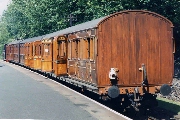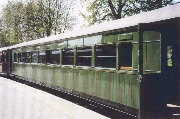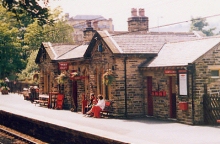
Vintage
Carriages Trust
Education pages
![]()
Topic:
Wartime Evacuation of children.
Activities during Group Visit to Ingrow Museum of Rail Travel
| Carriages on display in the Museum include three Metropolitan Railway carriages - photo upper right; built in 1910, 1919 and 1923: and one carriage built in 1924 for the Southern Railway (photo lower right). All four were still in use during the Second World War, in and around London. |  |
 |
These represent two of the types of carriages in which children would have travelled when they were evacuated from London. The Southern Railway carriage (referred to as the "Chatham" coach - it was designed by the South Eastern & Chatham Railway, which became part of the Southern Railway in 1924) is a corridor carriage, whilst the three Metropolitan carriages have no corridor, just compartments. Some of the carriage prints on display in the advertising panels just below the luggage racks in the Metropolitan carriages are replicas of wartime warnings concerning blackout and air raids. All these carriages have compartments which can be entered.
Ingrow
Railway Station is approximately 200 yards from the Museum, at the
other end of Ingrow Station Y ard.
It is a typical small Midland Railway station, with its single platform,the
usual station buildings, and has a railway tunnel mouth at the platform
end. The oil lamps which provide illumination for the platform in hours
of darkness are often on view. Other railway station platform furniture
includes platform seats, trolleys and barrows, milk churns and a selection
of passenger luggage.
ard.
It is a typical small Midland Railway station, with its single platform,the
usual station buildings, and has a railway tunnel mouth at the platform
end. The oil lamps which provide illumination for the platform in hours
of darkness are often on view. Other railway station platform furniture
includes platform seats, trolleys and barrows, milk churns and a selection
of passenger luggage.
Suggested programme for your visit:
Each child on arrival to be wearing a label and carrying a gas mask case (if constructed - see suggestions for pre-visit activities), possibly also a favourite toy and a suitcase (again as suggested within pre-visit activities - suitable suitcases are available on loan from the Museum if requested in advance).
We recommend splitting your group into two smaller groups - one to first visit Ingrow Station and the other the Museum of Rail Travel, changing over at a convenient half way point.
At
Ingrow Station we would suggest small-group observation and discussion
as follows:
On the platform: the name of the Station and how and why it is
displayed: the platform furnishings and their purpose (seats, lamps, milk
churns, advertising signs): the tunnel and its purpose.
Within the station building: the waiting room: posters: fireplace
(with real coal!): foundation stone: Booking Office window. Entry into
the Booking Office itself may be possible but should not be promised.
You may like to print out a Worksheet covering the visit to Ingrow Station - this is a MS Word .doc file.
There is a great deal to be seen at the Museum of Rail Travel, and we would recommend a preliminary visit - free admission is given to teachers or others planning a school (or other) visit. However, for the theme of "Evacuation" we would suggest splitting into groups of not more than ten (including a teacher or other supervising adult) and assigning each group to a separate compartment within one of the Metropolitan Railway carriages. Observation and discussion points could then include: carriage furnishings - carriage prints, the communication cord, luggage racks: available space (if time permits, possibly contrast that provided for First Class and for Third Class passengers): implications of the lack of corridors.
Again, you may like to print out (as a MS Word .doc file) a Worksheet covering this visit to the Museum of Rail Travel.